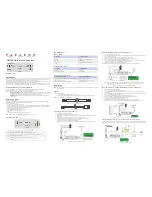
6
Service
Maintenance
Troubleshooting
Your Tripp Lite product is covered by the warranty described in this manual. A variety of Extended Warranty and On-Site Service Programs
are also available from Tripp Lite. For more information on service, visit www.tripplite.com/support. Before returning your product for
service, follow these steps:
1. Review the installation and operation procedures in this manual to insure that the service problem does not originate from a
misreading of the instructions.
2. If the problem continues, do not contact or return the product to the dealer. Instead, visit www.tripplite.com/support.
3. If the problem requires service, visit www.tripplite.com/support and click the Product Returns link. From here you can request a
Returned Material Authorization (RMA) number, which is required for service. This simple on-line form will ask for your unit’s model and
serial numbers, along with other general purchaser information. The RMA number, along with shipping instructions will be emailed to
you. Any damages (direct, indirect, special or consequential) to the product incurred during shipment to Tripp Lite or an authorized
Tripp Lite service center is not covered under warranty. Products shipped to Tripp Lite or an authorized Tripp Lite service center must
have transportation charges prepaid. Mark the RMA number on the outside of the package. If the product is within its warranty period,
enclose a copy of your sales receipt. Return the product for service using an insured carrier to the address given to you when you
request the RMA.
Your Inverter requires no maintenance and contains no user-serviceable or replaceable parts, but should be kept dry at all times.
Periodically check, clean and tighten all cable connections as necessary, both at the unit and at the battery.
Please check the following before sending the Inverter in for service:
Symptom
Problem
Correction
Alarm sounds.
Low battery voltage (<10.5 V).
Turn Inverter OFF and run engine to recharge vehicle battery.
Output overload.
Turn Inverter OFF and remove overload by unplugging high-wattage
devices. Load should not exceed your Inverter's maximum continuous
output power (see Specifications).
Inverter does not turn ON when
Automatic Inverter shutdown due to
Turn Inverter OFF and run engine to recharge vehicle battery.
power switch is turned ON.
low battery voltage (<10V).
Automatic Inverter shutdown due to
Turn Inverter OFF and remove overload by unplugging high-wattage
output overload.
devices. Load should not exceed your Inverter’s maximum continuous
output power (see Specifications).
Blown fuse.
Replace fuse with standard automotive fuse of identical amperage
(see Specifications).
Inverter is unable to power
Battery running low. Low battery
Turn Inverter OFF and run engine to recharge vehicle battery.
connected equipment.
voltage reduces Inverter power output.
Connected equipment load exceeds Inverter’s Turn Inverter OFF and remove overload by unplugging high-wattage
maximum continuous output power.
devices. Load should not exceed your Inverter's maximum continuous
output power (see Specifications).
Connected equipment experiences Loose connections.
Check and secure all connections.
audio/video distortion.
Audio/video interference.
Reposition equipment antennas and Inverter.






































